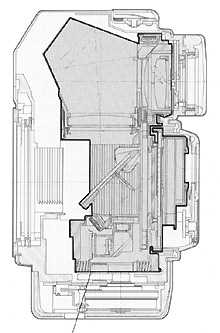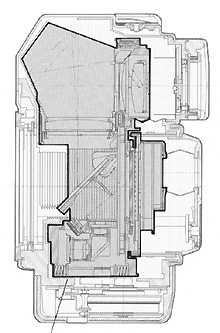The Contax AX autofocus body

A camera able to use existing manual focus lenses but provide autofocus
capabilities seems, at first, like a wish-list winner. There are problems
associated with the idea which are hard to overcome, and the Contax AX
is the first body design to do so.
The AX was first shown in Britain at Focus on Imaging in prototype form.
It worked, but with some rather erratic behaviour and visible limitations.
Many questions raised about the camera could not be answered clearly, and
it seemed that this £1,900 body was only going to match the focusing
speed of a first generation AF SLR.
You would assume that the best way to tackle the question of creating a
variable back focus distance p; the space between the rear of the lens
and the film plane p; would be to fold it using surface silvered mirrors,
and then move the mirrors. This is the only simple afocal solution to keeping
the lens and film in fixed positions, but varying the distance between them.
This is roughly how the focusing of mirror lenses works, including one 'folded
path' catadioptric tele of the mid-70s.
Such a light path demands a relatively long back focus and narrow exit
pupil to start with, as there isn't the space for fat stubby cones of light.
However, Fast wide-angles and short teles can have substantial rear elements
and relatively short back focus distances p; and if Contax is known
for anything in particular, it's for lenses of this kind.
A body designed with a folded lightpath and mirrors is also going to be
highly unconventional (see my diagram). This
may not appeal to users.
Contax's solution, which is less optically elegant, is to mount the entire
film back and track, darkchamber and mirror, focusing screen and primary
viewing optics including pentaprism on a movable track. Auto focus is achieved
by a backwards shunt of up to 10mm from the infinity position. This makes
the entire body over 1cm thicker and calls for a decent sized motor in the
base.


Above: the close-focus or macro position of the AX's film assembly. Right:
infinity focus.
Despite superhuman engineering efforts, moving all this lot around is just
not the same as shifting a single group inside a lens. As a comparison,
the original 135mm 2.8 AF tele for the first Minolta 7000 p; an internal
focusing lens of exceptional quality p; blows away the Contax AX effortlessly.
A new Canon USM lens, of any type including fairly chunky zooms, blows away
the Minolta even when fitted to the latest faster Minolta bodies. And the
new Vectis Minolta lenses, which have internal motors like the Canon, seem
even faster still.
These lenses are moving single, very light, perfectly balanced lens elements
through a millimetre or two. The AX is moving perhaps one hundred times
the weight of the lightest internal AF assembly, through five times the
travel.
Unless the AX prototype was fitted with a very slow motor p; unlikely
p; some of the advanced features like predictive moving subject focus-tracking
are probably necessary to cope with normal movement, rather than aimed at
tackling the fastest sports. Yet this camera has a 5 fps drive!
My feeling, on trying out the AX prototype very casually, was that it may
have specific applications in servo photography. It has the advantage that
a lens can be pre-focused on a close distance, as the entire natural focusing
range of the lens is still enabled, and will then auto focus on small movements
of a subject.
It also converts standard lenses into semi-macros, and wide angles into
true macro focusing systems, by extending all close focus ranges with a
virtual 10mm extension tube.
The 10mm focusing span is not significant enough to provide AF with lenses
over 300mm, and can not handle macro magnifications around life size with
bellows, but apart from this the AX body adds AF functions to almost any
optical assembly you can stick on the lens mount.
Aimed at a range of targets, we found that the AX had peculiar failings
and strengths p; vertical lines, the ideal subject for older AF systems,
could throw it completely, while apparently featureless textures were focused
on instantly without hunting.
Readers will begin to see that the AX body, despite its obvious limitations,
starts to fit a specific set of uses. It should handle wildlife subjects
unusually well, and looks finely tuned for portraits and fashion work. These
are fields where moderate subject movement is normal, and the grinding exceeding
slow doesn't matter as long as the grinding is exceeding fine.
For sports work, the AX is just not even beginning to get there; no-one
is going to drop a Canon ultrasonic motored long tele in favour of the Contax
equivalent. Nor is it much use for architectural work (the focusing just
doesn't function well on geometric lines and shapes) or copying, where the
argument surely must be that AF is nothing but a nuisance to start with.
The refinements of the AX focusing system include a fixed 'macro' mode
where the film plane is moved back and you then use manual focus, a continuous
predictive mode (which we would have to test carefully in the light the
slowness of the prototype) and a single-focus mode where the camera finds
its own focus point but lets you fine-tune manually without over-riding.
The AF also has an auxiliary focusing light.

Finally it must be said that the Contax AX is an immensely strong, well
specified Contax body with titanium top cover, die-cast main unit, shutter
speeds to 1/6,000th, full automation, auto bracketing, five frames per second
motor wind, 1/200th flash speed, dioptric correctiong eyepiece, data back
option (above, with some exceptional functions), spot metering p; the
works. It is not all that much more expensive than other similar Contax
SLRs with the same functions.
Given all this, the body has more appeal than it would have were it just
a lesser-featured Contax with AF as its major selling point. It may be a
bulky SLR, but it can be used manually just as well as any other Contax
RT-series model.
My guess is that the prototype's apparent lack of enthusiasm will not be
so apparent in production bodies. If it is, few sales will be made as a
result of over-the-counter demonstrations. The principle is a sound one,
even if moving the entire camera innards along with film cassette, take-up
spool, prism and shutter may seem to impose a ceiling on efficiency.
The Advanced Film Format, because of its dimensions, lends itself much
better to an autofocus body using a folded mirror light path but accepting
standard 35mm SLR lenses. The beauty of folded mirror design is that the
mirror assembly only needs to move half the distance of the required focus
shift and can be extremely light, while viewing can be accomplished directly
through the lens either with a moving primary mirror or a semi-silvered
one.
Where the Contax does provide a valuable pointer is in the future for an
autofocus Leica fully compatible with the M system. Remove the need to move
a viewing system, and only the film plane and shutter need to shunt. For
technical reasons, any focal plane shutter must stay a constant distance
from the film surface, or its faster shutter speeds will no longer be constant.
By providing any lens with an 'AF' lock position at its closest focus and
focal length identifier p; a possible retro-conversion p; an external
AF rangefinder could be made to move the film plane forwards, eliminating
the need for a much deeper body.



